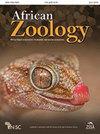Comparative Avifaunal Richness and Diversity in Invasive Acacia dealbata Patches and Adjacent Montane Grasslands
IF 0.5
4区 生物学
Q4 ZOOLOGY
引用次数: 1
Abstract
Invasive alien species are regarded as the second greatest threat to biodiversity globally. Yet, at a local scale their effects may vary, underlying the requirement for more local-scale studies across taxa and settings. Here we consider the effects of an alien invasive tree (Acacia dealbata, 5–8 m tall) on avifaunal numbers, richness and diversity in A. dealbata patches of three sizes relative to adjacent montane grasslands. Analysis of historical aerial photographs showed that A. dealbata first occurred in the area in the late 1930s/early 1940s and has continued to spread, despite some efforts by the landowner to keep it in check. It now covers approximately 11% of the site. This has provided habitat for a number of bird species more characteristic of wooded vegetation types. The number, richness and diversity of birds were greater in A. dealbata patches than the adjacent grasslands of equivalent size. These measures increased with increasing patch size, but more rapidly for A. dealbata patches than grassland ones. Only six of the 48 species of birds recorded were common between the two vegetation types. The most common feeding guild in the A. dealbata patches was insectivores, whereas in the grasslands it was omnivores. Although the invasion of A. dealbata has added to the habitat diversity of the area, thereby facilitating increased avifaunal diversity, if it continues to spread, then the populations and perhaps richness of grassland birds are likely to be negatively affected.入侵金合欢斑块和邻近山地草地的鸟类丰富度和多样性比较
外来入侵物种被认为是全球生物多样性面临的第二大威胁。然而,在地方尺度上,它们的影响可能会有所不同,这就要求在分类群和环境中进行更多的地方尺度研究。在这里,我们考虑了外来入侵树(Acacia dealbata,5-8米高)对三种大小的A.dealbata斑块的鸟类数量、丰富度和多样性的影响。对历史航拍照片的分析显示,A.dealbata首次出现在该地区是在20世纪30年代末/40年代初,尽管土地所有者做出了一些努力来控制它,但它仍在继续传播。它现在覆盖了大约11%的场地。这为许多鸟类提供了更具树木植被特征的栖息地。在A.dealbata斑块中,鸟类的数量、丰富度和多样性都大于邻近同等大小的草原。这些措施随着斑块面积的增加而增加,但对于A.dealbata斑块来说比草地斑块更快。在记录的48种鸟类中,只有6种在这两种植被类型之间是常见的。在A.dealbata地区,最常见的觅食群体是食虫动物,而在草原上则是杂食动物。尽管A.dealbata的入侵增加了该地区的栖息地多样性,从而促进了鸟类多样性的增加,但如果它继续传播,那么草原鸟类的数量和丰富度可能会受到负面影响。
本文章由计算机程序翻译,如有差异,请以英文原文为准。
求助全文
约1分钟内获得全文
求助全文
来源期刊

African Zoology
生物-动物学
CiteScore
2.60
自引率
9.10%
发文量
18
审稿时长
>12 weeks
期刊介绍:
African Zoology , a peer-reviewed research journal, publishes original scientific contributions and critical reviews that focus principally on African fauna in terrestrial, freshwater, and marine ecosystems. Research from other regions that advances practical and theoretical aspects of zoology will be considered. Rigorous question-driven research in all aspects of zoology will take precedence over descriptive research. The Journal publishes full-length papers, critical reviews, short communications, letters to the editors as well as book reviews. Contributions based on purely observational, descriptive or anecdotal data will not be considered.
The Journal is produced by NISC in association with the Zoological Society of South Africa (ZSSA). Acceptance of papers is the responsibility of the Editors-in-Chief in consultation with the Editors and members of the Editorial Advisory Board. All views expressed are those of the author and not necessarily those of the Editors or the Department.
 求助内容:
求助内容: 应助结果提醒方式:
应助结果提醒方式:


